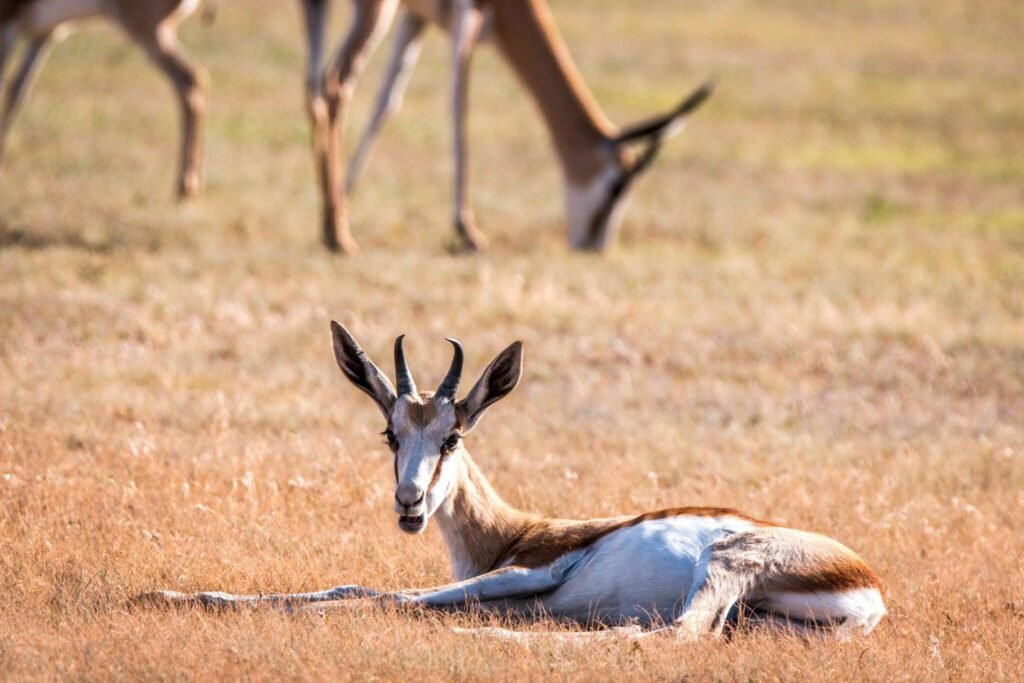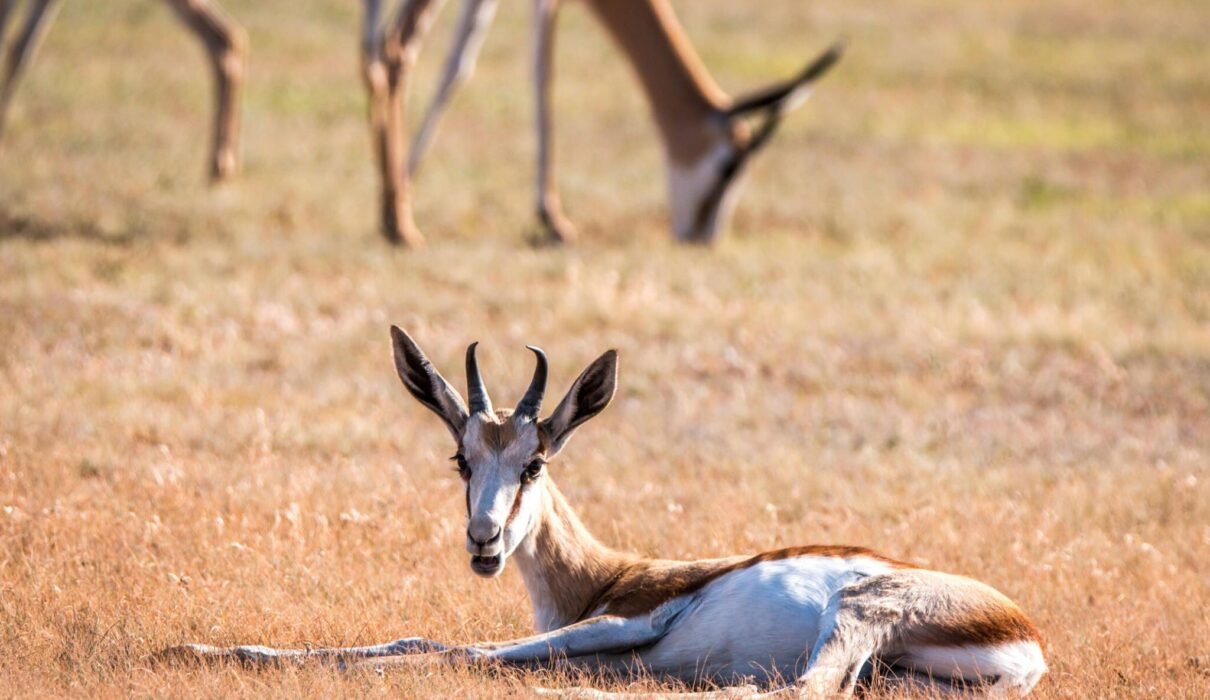Meet the Antelopes of Serengeti National Park : Serengeti National Park, one of the most famous wildlife reserves in the world, is home to an incredible variety of wildlife. Among its most iconic residents are the antelopes. These graceful animals play a vital role in the park’s ecosystem, supporting predators such as lions, cheetahs, and leopards while maintaining the balance of the savannah’s plant life. From the swift Thomson’s gazelle to the majestic eland, Serengeti offers an unmatched diversity of antelope species.
In this guide, we’ll explore the different types of antelopes you can find in Serengeti National Park, their unique behaviors, and where you are most likely to spot them during your safari.
Read more about the wildlife of Serengeti National Park here.

Meet the Antelopes of Serengeti National Park : Importance of Antelopes in Serengeti’s Ecosystem
Antelopes are a crucial part of the Serengeti ecosystem. As herbivores, they help control the growth of vegetation, ensuring the balance between plant and animal life. Many of the park’s predators rely on antelopes as a primary food source, which makes them essential to the survival of big cats and other carnivores. Their ability to migrate and graze over large areas also helps in nutrient cycling, spreading seeds and promoting plant growth across the plains.
For a deeper understanding of how antelopes contribute to the ecosystem, check out this informative wildlife article.
Meet the Antelopes of Serengeti National Park : Common Antelope Species in Serengeti National Park
Thomson’s Gazelle
The Thomson’s gazelle, one of the smallest and fastest antelopes, is commonly found throughout Serengeti’s open plains. Known for their impressive speed, these gazelles can reach up to 60 mph (96 km/h) in short bursts, which helps them escape predators like cheetahs.
- Habitat: Open grasslands.
- Behavior: Herding in groups, often mixing with other species like wildebeests and zebras.
Learn more about the survival strategies of Thomson’s gazelles.
Grant’s Gazelle
Slightly larger than the Thomson’s gazelle, the Grant’s gazelle is another common sight in the Serengeti. With their longer horns and elegant stature, these animals are often mistaken for their smaller cousins but can withstand harsher conditions, often staying behind when other animals migrate.
- Habitat: Semi-arid grasslands and savannas.
- Behavior: Solitary or small groups, known for their endurance in drier areas.
Discover how Grant’s gazelles thrive in arid environments.
Impala
The impala is one of the most graceful antelope species in Africa. Found in the Serengeti’s woodland and savanna regions, impalas are easily recognizable by their slender bodies and lyre-shaped horns. Known for their agility, impalas can leap up to 3 meters in the air to escape predators.
- Habitat: Woodland edges and savannas.
- Behavior: Highly social, living in large herds with structured hierarchies.
Explore more facts about impalas and their behaviors.
Topi
Topis are known for their striking reddish-brown coats and distinctive dark patches on their legs and faces. These antelopes are often seen in small groups and prefer to graze in the park’s grasslands.
- Habitat: Floodplains and grasslands.
- Behavior: Territorial, with males defending prime grazing areas.
For more insights into topis and their territorial behavior, click here.
Eland
The eland is the largest antelope species in Africa and can weigh over 900 kilograms (1,984 lbs). Despite their massive size, elands are known for their calm demeanor and can be surprisingly agile, even jumping fences when threatened.
- Habitat: Woodlands and open plains.
- Behavior: Herd animals, often traveling in groups of up to 100 individuals.
Learn more about the habits of the mighty eland.
Meet the Antelopes of Serengeti National Park : Rare and Lesser-Known Antelope Species in Serengeti
Oribi
The oribi is a small and rare antelope species found in the Serengeti. With its slender body and elongated neck, the oribi is adapted to spotting predators in the tall grass. They are typically solitary or found in pairs, making them harder to spot during a safari.
- Habitat: Grasslands and savannas.
- Behavior: Shy and elusive, often hiding in tall grasses.
Discover more about the elusive oribi here.
Steenbok
Another small and elusive antelope is the steenbok. Standing just about 60 cm (24 inches) tall at the shoulder, steenboks are well camouflaged in the dry grasses of Serengeti. These solitary creatures prefer dense bushland areas where they can graze undisturbed.
- Habitat: Dense bushlands and open plains.
- Behavior: Territorial, often seen alone or in pairs.
Read about the fascinating life of steenboks.
Meet the Antelopes of Serengeti National Park : Best Places to Spot Antelopes in Serengeti National Park
While antelopes can be found throughout Serengeti National Park, certain areas are particularly rich in these species. Here are some top locations for antelope sightings:
- Seronera Valley: The heart of Serengeti, where diverse wildlife, including impalas, Thomson’s gazelles, and topis, thrive.
- Grumeti River: Known for its rich grazing grounds, this area is home to herds of antelopes year-round.
- Western Corridor: This area provides prime habitat for elands and Grant’s gazelles, especially during the dry season.
Check out more travel tips for Serengeti’s best wildlife viewing spots.
Meet the Antelopes of Serengeti National Park : Conservation of Antelopes in Serengeti
Conservation efforts in Serengeti National Park are critical to preserving its antelope populations, which face threats from poaching, habitat loss, and climate change. Organizations working in the region focus on anti-poaching measures, habitat restoration, and creating awareness about the importance of these animals to the ecosystem.
- Anti-Poaching Initiatives: Rangers patrol the park to prevent illegal hunting.
- Habitat Protection: Conservation efforts ensure the preservation of grasslands and water sources essential for antelopes.
To learn more about the ongoing conservation efforts, visit WWF’s Serengeti conservation page.
Antelope Behavior: Mating, Feeding, and Social Structures
Mating Seasons and Rituals
Most antelope species in Serengeti have specific breeding seasons that coincide with the wet season when food is abundant. During this time, males will often compete for dominance through displays of strength and horn fights.
- Thomson’s Gazelle: Males establish territories and fight off rivals to attract females.
- Impala: Rutting season occurs during the rains, where males compete fiercely for mates.
Learn more about the mating habits of African antelopes here.
Feeding Habits
Antelopes are primarily herbivores, feeding on grasses, leaves, and shoots. Depending on the species and the season, their diets can vary significantly.
- Grazers: Species like topis and Thomson’s gazelles mainly graze on short grasses.
- Browsers: Elands and impalas often browse on leaves and twigs during the dry season.
For more information on antelope diets and feeding patterns, visit this article on herbivorous animals.
Social Structures and Group Dynamics
Many antelopes, such as the impala and Thomson’s gazelle, live in large herds for protection against predators. Others, like the eland, form loose social groups and are less territorial.
- Herding Species: Impalas live in large herds, with a single dominant male overseeing a group of females.
- Territorial Species: Grant’s gazelles are more solitary and will defend their territories from rivals.
Find more on antelope social behaviors here.
Antelope Threats and Survival Strategies
Despite being incredibly fast and agile, antelopes face numerous threats in the wild. Predators such as lions, cheetahs, and hyenas constantly hunt them, while environmental challenges like droughts can limit their food supply.
- Predators: Lions and cheetahs target antelopes, with gazelles being a common prey due to their size.
- Drought: In years of poor rainfall, food and water become scarce, leading to increased mortality among younger or weaker antelopes.
Read more on the natural predators of Serengeti’s antelopes.

Meet the Antelopes of Serengeti National Park : Conclusion
The antelopes of Serengeti National Park are among the most remarkable creatures to witness on safari. From their swift movements to their delicate balance within the ecosystem, these animals offer a captivating glimpse into the wonders of the African wilderness. Whether you’re watching a herd of Thomson’s gazelles bounding across the plains or observing a solitary eland grazing in the distance, the antelopes of Serengeti will leave you with an appreciation for nature’s resilience and beauty.
For more information on planning your safari to Serengeti, visit Kilimanjaro Climb Specialist or Eddy Tours & Safaris.

